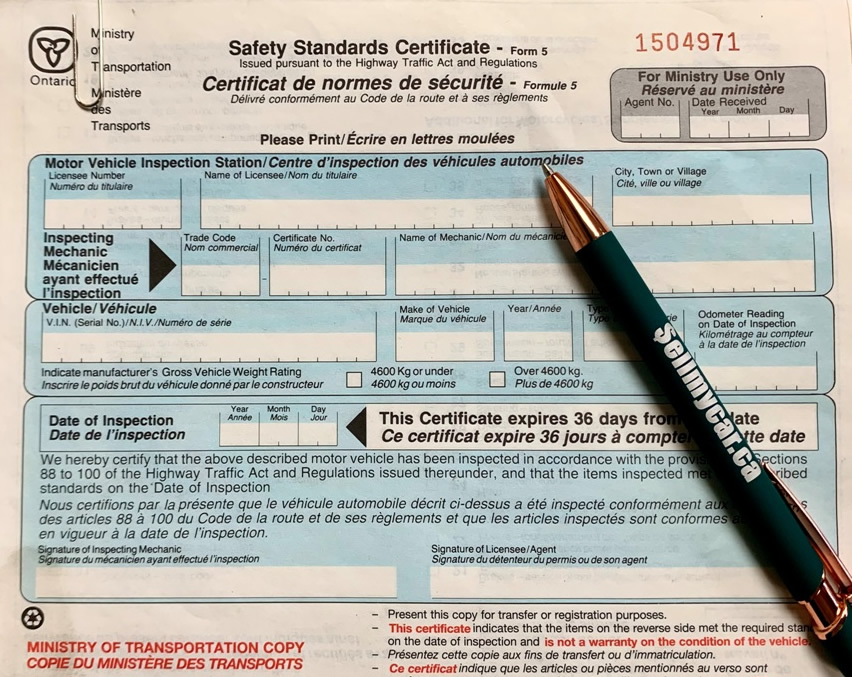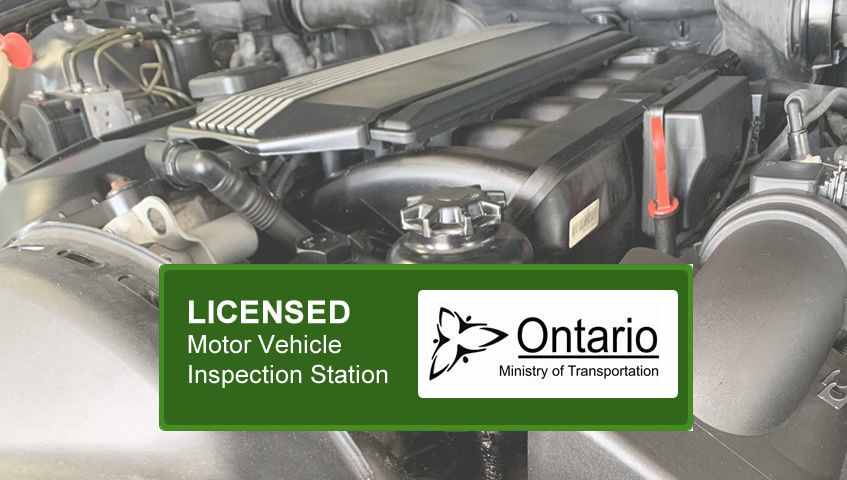Ontario Safety Standard Certificate: Why It’s Important and How to Get It
An Ontario Safety Standard Certificate is a document that confirms that a vehicle meets the minimum safety standards set by the Ontario Ministry of Transportation (MTO). This certificate is required for most used vehicles that are sold or registered, and it must be purchased before the transfer of ownership or registration can be completed. It is a way to ensure that vehicles on Ontario’s roads are safe and roadworthy, and it helps protect both drivers and passengers from potential harm.

When do you need a Vehicle Safety Inspection in Ontario?
In Ontario, vehicles require a safety inspection in several different scenarios:
- When registering a vehicle from another province or country.
- When a vehicle changes ownership, unless it is exempt, such as transfers within a family, but you must complete a spousal declaration.
- When a commercial vehicle undergoes an annual inspection.
- When a salvage vehicle is being rebuilt for road use.
- When changing the status of a vehicle from unfit to fit.
Note that the requirements for safety inspections can vary depending on the type of vehicle and its intended use. For example, different standards apply for passenger vehicles, motorcycles, and commercial vehicles. If you’re unsure whether your vehicle requires a safety inspection, you can contact the MTO.
How many copies of the Safety Certificate are there?
There are three copies of the Safety Standard Certificate available:
- Blue copy known as the “MTO copy,” which must be presented to an MTO office during a transfer.
- Yellow copy known as the “Purchaser’s copy,” which is meant for the purchaser’s personal records.
- Lastly, a copy is kept in the “Mechanic’s book” for their records.
Where can you get a Safety Certificate for your vehicle?
You can go to any Motor Vehicle Inspection Center (Mechanics) licensed by the MTO to get a Safety Certificate for your vehicle. These facilities are authorized to perform safety inspections and issue Safety Certificates for vehicles that pass the inspection. You can find a vehicle inspection center near you by searching online or contacting MTO for assistance.

To get an Ontario Safety Standard Certificate, your vehicle must pass a safety inspection conducted by a licensed mechanic. Once your vehicle has passed the inspection, you will be issued a Safety Standard Certificate, which is valid for 36 days. Before you leave the inspection garage, make sure to check your certificate for any mistakes, and that the Vehicle Identification Number (VIN) matches the number on your permit. The VIN number can be located in your vehicle ownership, or you can purchase a Used Vehicle Information Package from ServiceOntario. Double-check the color, mileage, and the year, month, and day as well.
What specific things are checked during a vehicle Safety Inspection?
During a vehicle safety inspection in Ontario, the following specific things are typically checked to ensure that the vehicle is safe to operate on the road:
- Brakes: The condition and functionality of the brakes, including the parking brake, are checked to ensure they are in good working order.
- Steering and suspension: The steering and suspension systems are inspected to ensure they are functioning properly and that all components are securely fastened.
- Tires: The condition and tread depth of the tires are checked, and the tires are inspected for any signs of damage or wear that could affect their safety.
- Lighting: All exterior lighting, including headlights, taillights, mirrors, and turn signals, are checked to ensure they are working properly.
- Horn: The horn is tested to ensure it is loud enough to be heard from a reasonable distance.
- Windshield wipers: The condition and functionality of the windshield wipers and washers are checked to ensure they can clear the windshield effectively.
- Exhaust system: The exhaust system is inspected for leaks and any signs of damage that could affect its safety.
- Fuel system: The fuel system is inspected for leaks and any signs of damage that could affect its safety.
- Seatbelts: The condition and functionality of the seatbelts are checked to ensure they are in good working order.
- Oil leaks: The undercarriage of the vehicle is inspected for any leaks that could affect its safety.
- Frame components: The frame is checked for any problems, holes, and rust that could affect its safety.
- Instrument Cluster: The functionality of the speedometer is checked to ensure accuracy.
How much does a Safety Inspection Certificate cost?
The cost of a safety standard inspection is not regulated by the government and is different at each Mechanic. The cost of a safety inspection certificate can vary depending on a few factors, such as the type of vehicle being inspected, the location where the inspection is taking place, and any additional services or repairs that may be needed to pass the inspection. In order to get an accurate estimate of the cost, it’s best to contact a few local authorized inspection stations. They should be able to provide you with more information on the specific costs associated with obtaining a safety inspection certificate in your location.
Can I register my car without having a Safety Standards Certificate?
It is possible to register a vehicle that does not have a Safety Standards Certificate, but you will not be issued license plates for the vehicle until it passes the required safety inspection and obtains the certificate. To clarify, the vehicle can be registered with the Ministry of Transportation, but it will be marked as “unfit” on the registration. This means that the vehicle is not allowed to be driven on public roads until it has passed the safety inspection and obtained the certificate. Once the vehicle passes the safety inspection and obtains the certificate, you can then get license plates and legally drive the vehicle.
What happens if my vehicle fails the Safety Inspection?
If your vehicle fails a safety inspection, it means that it does not meet the minimum safety requirements necessary to be registered and driven on the road. Once your vehicle fails the inspection, you will usually receive a report with specific problems that need to be addressed. You will then need to take your vehicle to a mechanic or repair shop to have the necessary repairs made. After the repairs are completed, you will need to do a re-inspection to ensure that the issues have been corrected and that your vehicle now meets the required safety standards. It’s important to keep your vehicle in good working order to ensure that it is safe to drive and to avoid failing a safety inspection. Regular maintenance and addressing any issues as soon as they arise can help prevent problems from becoming more serious and costly in the long run.
How long is a safety standard certificate valid for?
In Ontario, a vehicle safety certificate is typically valid for 36 days from the date of issuance. But, that while a safety certificate is required for selling a used vehicle, it does not provide any guarantee or warranty on the condition of the vehicle beyond the date of issuance. If the safety certificate expires before you register your vehicle, you will have to pay for a new inspection and certificate.
Do I need a safety certificate to buy or sell a car in Ontario?
If you are planning to buy or sell a car in Ontario, you might be wondering if you need a safety certificate. The answer is yes – if you are buying a car and would like to register and get plates, you must obtain a safety certificate first. You can ask the seller to provide one or buy the car as is and obtain your own safety certificate. If you are selling a car, a safety certificate is not required by law, but it’s a good idea to obtain one because buyers may feel uncertain about making an offer without it.
At Sell My Car, we purchase used vehicles in their current state, without requiring a safety standard certificate. Our team will come to your location to handle all necessary paperwork and make the process as convenient as possible for you.
